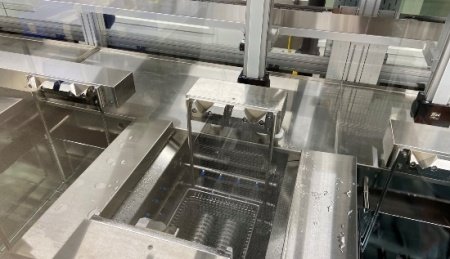
Cleanliness For Optimal Diagnostics And Therapy
X-ray tubes are the basis of a number of diagnostic and therapeutic procedures in medicine. Manufacturing precision and cleanliness of the individual parts are key factors for the functional reliability and longevity of these high-tech components. A leading manufacturer relies on equipment from Ecoclean and UCM for cleaning.
Shortly after the discovery of X-rays by Wilhelm Conrad Röntgen on November 8, 1895, the development and manufacture of X-ray tubes at Philips Medical Systems DMC GmbH began with Carl Heinrich Florenz Müller, a glassblower born in Thuringia. As early as March 1896, he made the first X-ray tube in his workshop in Hamburg. Three years later, the technology pioneer was granted the first patent for an X-ray tube with water-cooled anti-cathode. The breathtaking pace of tube development and the enormous success of X-ray technology spurred demand worldwide, turning the craftsman’s workshop more and more into a specialist factory for X-ray tubes. In 1927, Philips, the only shareholder at the time, took over the factory.
Innovation and High Manufacturing Precision
Ever since then, the company has been shaping X-ray technology with innovative solutions and continuous improvements. The products used in Philips Healthcare systems, as well as those sold under the Dunlee brand, contribute significantly to advances in diagnostic imaging, computer tomography and interventional radiology.
“Besides modern manufacturing technologies, high precision and ongoing process optimisation, component cleanliness plays an important role in ensuring the functional reliability and longevity of our products,” says André Hatje, Senior Engineer for Process Development in the X-ray Tubes Division. Residual particle contamination specifications that have to be met when cleaning the various X-ray tube parts underline this: a maximum of two 5 µm particles and one 10 µm particle.
Removing Molybdenum Grinding Dust With a Standard System
The high cleanliness requirements were one criterion when the plant for cleaning spiral groove bearing components was replaced. The bearings, which form the heart of high-tech X-ray tubes, are made of molybdenum. After the groove structure has been applied by laser, a dry grinding step is performed. This is followed by cleaning, during which the grinding dust and any traces of smoke from the laser process still present in the grooves must be removed. To simplify process validation, among other things, a compact standard machining was needed for this cleaning process. Against this backdrop, the process developer approached several cleaning equipment manufacturers, including Ecoclean GmbH in Filderstadt.
Equipped for Fine Cleaning
The machine for immersion and spraying processes is operated with the same acidic cleaning medium previously used at Philips and has a footprint of just 6.9 m2. It is fitted with three flood tanks for the washing step and two rinsing processes. Their flow-optimised, cylindrical design and upright position prevent dirt from accumulating in the tanks. In addition, each tank has a separate media circuit with full-flow filtration so that the cleaning and rinsing fluids are filtered during filling and emptying as well as in the bypass. The deionised water used for the final rinsing process is treated in the integrated Aquaclean system.
To continue reading this article, head on over to our Ebook!
Check these articles out:
Hypertherm Adds New Features To Rotary Tube Pro Software With Version Update
Hexagon And Plex Systems Announce Partnership To Deliver Smart Manufacturing Solutions
Automation! More Than Just Hardware
2021 Metals Analysis Outlook: Optimising Production Through Connectivity
SLM Solutions’ Next Disruption In Additive Manufacturing Vows To Impress
For other exclusive articles, visit www.equipment-news.com.
WANT MORE INSIDER NEWS? SUBSCRIBE TO OUR DIGITAL MAGAZINE NOW!
FOLLOW US ON: LinkedIn, Facebook, Twitter
